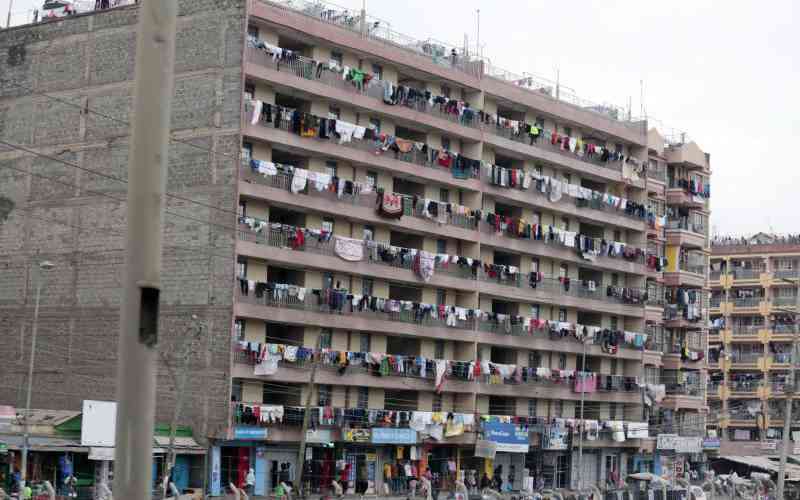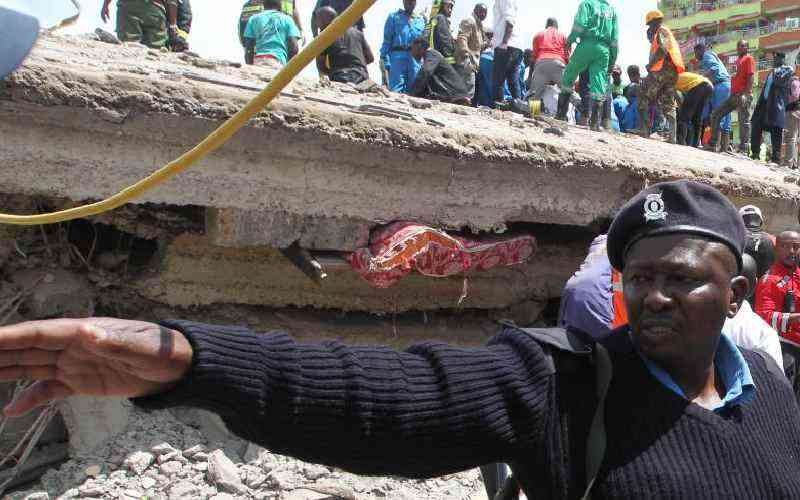Despite many efforts to revise the building code, the archaic document is still in use. Professionals advise that a new building code that recognises the housing situation in Kenya is the way to go, writes JECKONIA OTIENO
The Building Code, a regulatory document which spells out the regulations that should govern any type of buildings constructed in the country, has become obsolete in the face of numerous  |
Prof Robert Rukwaro, Lecturer, School of Architecture and Building Science, University of Nairobi. |
changes and challenges that have arisen in the sector; and truth be told, the Building Code only exists on paper as the reality on the ground is that many constructions have not adhered to it.
Looking at many towns in Kenya, it is easy to point out where the code has failed as a physical development control tool. Some of the rules are flouted even as authorities try to come up with a new code.
The current building code, also known as Local Government Act Cap 256, states clearly, for example, in articles 17 and 18 that the space in front of any building should be at least 20 feet (six metres frontage) while the space at the side where opening are located should be eight feet (2.4m). This is one of the laws that is broken blatantly as buildings in many parts of Nairobi sit cheek to cheek, with no allowance for even opening windows. A walk in the overpopulated areas of Mathare, Huruma, Kayole, Kibera and many other estates reveal that there is a constant fight for space as every little space that exists is taken by a tin-roofed kiosk. If not, there are hawkers spreading their wares.
Out of context
Kenya uses the metrical system (metres) while measurements in the current code are in the imperial system (feet). This, experts say, is to be changed in the new code.
One of the problems with the code, as Prof Robert Rukwaro, a lecturer at the University of Nairobi’s Department of Architecture and Building Sciences, notes is that most professionals have not internalised it.
Rukwaro notes that the code exists but most people do not understand what it really talks about because it is modelled on the British building building culture of the 1960s.
"The new code will come with a handbook, which will explain each clause so that people can get to understand what the clauses say explicitly without any ambiguity," he says.
He further states that the code is widely ignored because of the low penalty that is slapped on those flouting it. He, however, points out that the new code, which is in the pipeline, is seeking to have punitive charges that will deter all those who ignore the rules.
The Building Code states that every plot needs to have at least one access road, but concrete slums like those in Ongata Rongai obviously break this rule. Here, buildings are constructed in such a way that two vehicles cannot pass each other along the narrow access roads. These roads are meant to serve several plots, some of them lacking access roads completely.
The Director of Physical Planning in the Ministry of Lands, Augustine Masinde, states that areas like Rongai have a problem with the rules because of the land being owned on freehold tenure, so that the owners can develop whatever and however they deem fit. Arising from this the new building code requires any approval of physical developments by the Local Authorities must be on planned and serviced plots.
This compromised development control is the council’s mandate and is easily flouted.
Political interference
Stay informed. Subscribe to our newsletter
Masinde also points out that the Building Code and the Physical Planning Act complement each other. He notes that instead of using physical planners to give them plans, developers sometimes resort to using land surveyors who are not planners.
He also states that the local authorities that should play the role of policing have been reduced to toothless bulldogs due to political interference. This has made them largely ineffective in discharging their duties.
The vice chairperson of the Architectural Association of Kenya, Waweru Gathecha, agrees that indeed, the Building Code is doing a disservice to this country. He points out that the building is material-based rather than performance-based.
Gathecha states that the building code has failed to achieve its goal because of lack of implementation. The inspectorate function is ailing and thus development control is lacking.
"Those supposed to implement it are known but they are not doing their work as they should, which begs the question; if a new code is to be passed, what will change in terms of implementation?" Gathecha questions.
He recommends a more user-friendly code which can be understood by laymen, adding that the document is in the works.
The new code expected to be out in May this year seeks to emphasise the regulation of building construction. Among those to be added are accredited checkers who will check that structural safety standards of the building are adhered to; and an authorised person to educate the client on what is required when building.
When it comes to staircases and lifts, the code stipulates that there be a uniform stair rise, which is not always the case in many residential buildings. There are buildings where the staircase is not uniform or where the staircase is not properly positioned in a central way to serve the building. Every high-rise building is also required to have fire escape staircase apart from the main staircase.
This happens because there is no inspection as the building undergoes construction. Therefore, the developer changes the originally approved design in order to cut cost.
The new code is expected to be very stringent where adherence to the rules is concerned.
Low income housing is also being factored in the new code. The code seeks to have a minimum of 10.5 square metres as the minimum house size for low income settlements.
Council’s mandate
Rukwaro says that in the new code, proposals have been made to come up with multi-purpose rooms and incremental houses, which are more affordable for the low income earners.
On drainage, most buildings fall short of the standards required by the current code. It is true that the current code explicitly spells out the state in which buildings should be but most buildings in Nairobi are run down.
As stated in Article 243, the owner of a building shall not permit the building to remain in a ruinous dangerous or dilapidated condition.
In case these rules are flouted, the council is mandated to serve notice in writing to seek for action.
For physically disabled persons, the new building regulations have come up with stipulations that will make buildings favourable and friendly.
Cheaper materials
The current building code in its present form is simply unworkable. Experts argue that the Building Code has outlived its usefulness and is now a nuisance in the building sector.
"The Building Code is suited for countries in the temperate regions, not the tropics because it does not factor in materials and technologies that can be used within the tropics," notes Rukwaro, stating that the code is outdated.
Collins Kowuor, who is the chairperson of the Institution of Surveyors of Kenya, concurs that the building code is old and modelled along what the British left at independence.
He points out that the building materials allowed in the code cannot alleviate the housing problem that is facing Kenya currently. He takes an example whereby a standard house should be two-bedroom one, which is out of reach for many people.
It is for this reason that Kowuor calls for a speedy conclusion to the review of the code to allow for new standards to be put in place if the current shortfall is to be met.
"There are new models and cheaper material in the market, which could be used in order to solve the housing problem once and for all," states Kowuor.
 The Standard Group Plc is a
multi-media organization with investments in media platforms spanning newspaper
print operations, television, radio broadcasting, digital and online services. The
Standard Group is recognized as a leading multi-media house in Kenya with a key
influence in matters of national and international interest.
The Standard Group Plc is a
multi-media organization with investments in media platforms spanning newspaper
print operations, television, radio broadcasting, digital and online services. The
Standard Group is recognized as a leading multi-media house in Kenya with a key
influence in matters of national and international interest.
 The Standard Group Plc is a
multi-media organization with investments in media platforms spanning newspaper
print operations, television, radio broadcasting, digital and online services. The
Standard Group is recognized as a leading multi-media house in Kenya with a key
influence in matters of national and international interest.
The Standard Group Plc is a
multi-media organization with investments in media platforms spanning newspaper
print operations, television, radio broadcasting, digital and online services. The
Standard Group is recognized as a leading multi-media house in Kenya with a key
influence in matters of national and international interest.









